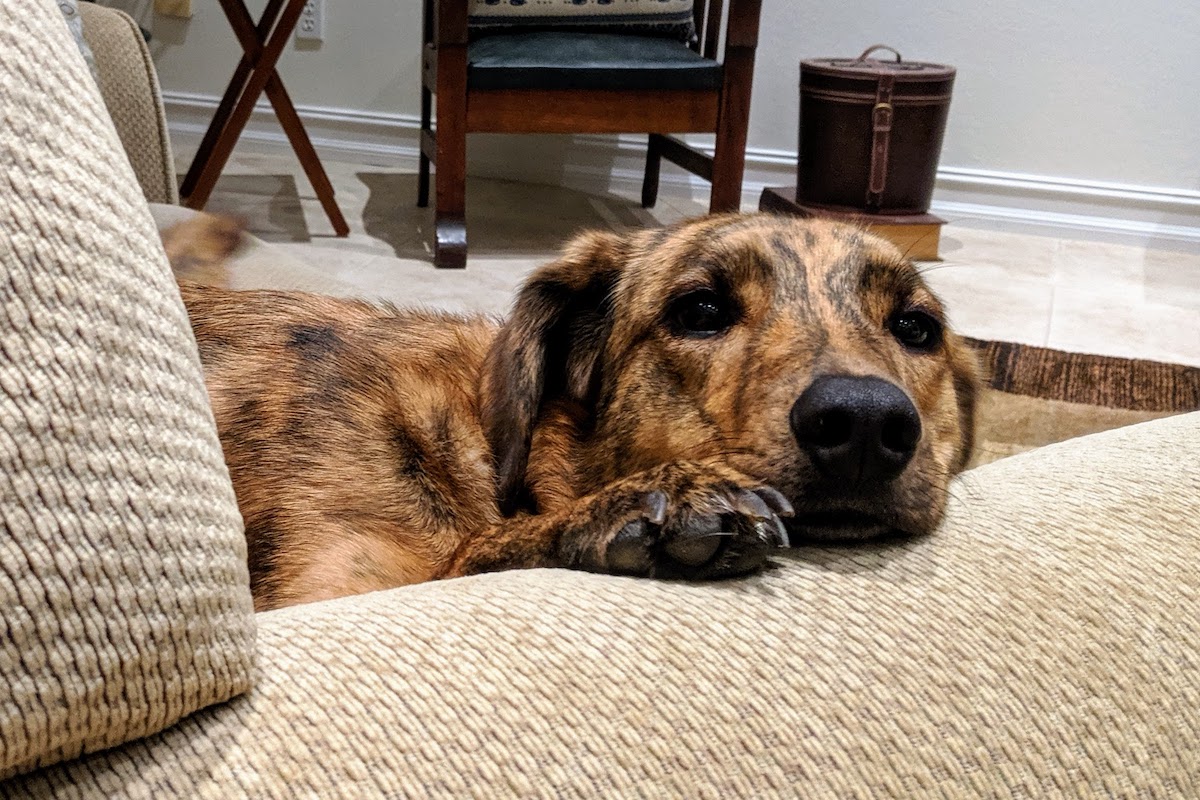
Adopting a Dog Internationally: Meet Mimi from Peru!
By: Sarah Stone
Skip to Section
Two years ago I traveled to Peru for work, and ended up adopting a dog named Mimi.
I was sent to Cusco for two weeks to write about an international volunteer organization that hosted travelers from all over the world. From construction, to health and medical care, to environmental conservation and beyond, there are many volunteer opportunities around Cusco and in the Sacred Valley—and I had the wonderful opportunity to visit a few of them.
One of the programs I covered was a dog shelter, called Cusco Protección de Animales. This organization spays and neuters stray cats and dogs, provides long-term shelter for animals that are abandoned or living on the streets, and helps find forever homes for them. International volunteers feed and care for the animals, help with fundraising, and provide companionship and support.
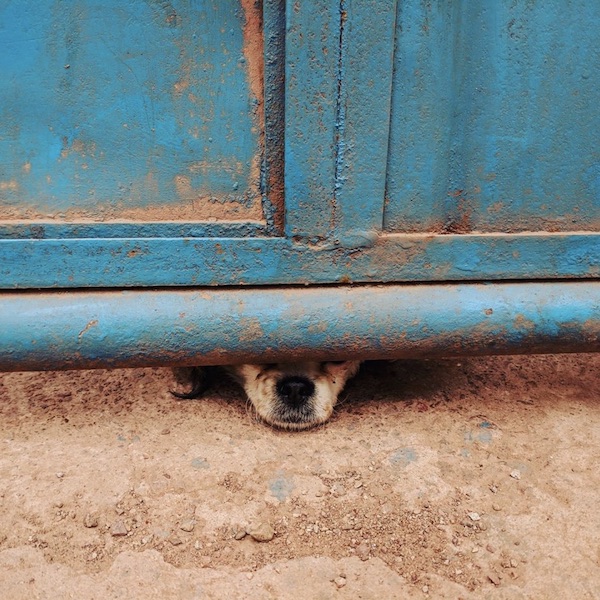
Boop the snoot to enter!
So Many Dogs!
Walking into the back yard of the shelter, I was greeted by a dozen dogs running in a circuit, excited to meet new visitors. I sat down on an old couch on the porch to interview the organization’s founder, Mila, as well as a few volunteers who were onsite that morning. Some dogs were on an exercise break outside, while others were inside eating lunch and resting. A little dog with three legs looked down from a stairwell above me, not joining the others who rushed by for pets.
“Her name is Hope,” Mila said. “She’s very shy.”
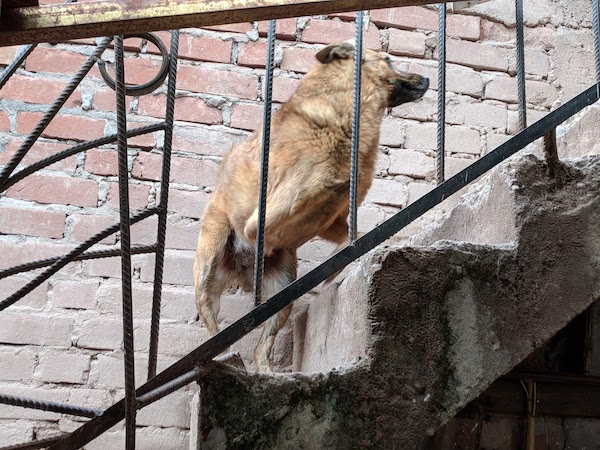
Hope, a shy, three-legged dog
Dogs jumped on the couch, ran in circles, and wrestled each other. I stopped trying to jot down notes, and instead took photos and chatted with Mila and the volunteers. Of the dogs that stopped by for pets, the tiger-striped mutt caught my eye. She was the only one with a brindle coat—and she was the only one who was wet, looking like she’d found a nice puddle to play in. Mila laughed, “That’s Mimi! She’s a naughty dog.”
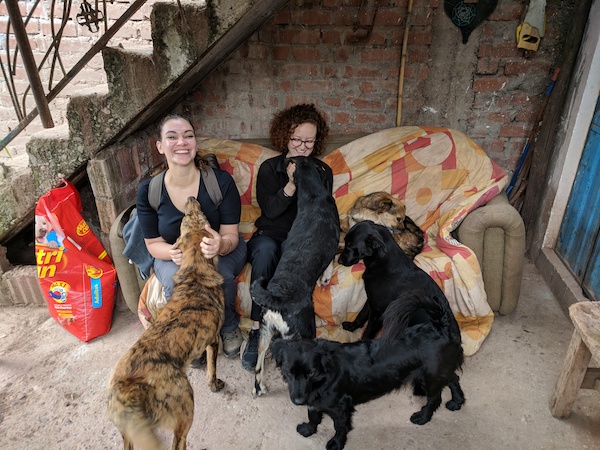
Meeting Mimi for the first time!
I stayed for an hour, becoming more intrigued by Mimi. I’d gone through a breakup a while before that and had been country-hopping solo since then, but by the time I landed in Peru, I was feeling lonely. While it was a relief to be single, I missed the two cats my ex-partner kept in the breakup.
“Can I adopt that striped dog?”
It just popped out of my mouth.
The volunteers and Mila turned to me—I’d said the magic words. They nodded in unison, suspiciously enthusiastically, eyes wide open—“Yes! Take her!”
Mila explained that Mimi was found abandoned as a puppy in a box at the train station—likely the only one in her litter that wasn’t sold to passers-by, so she was left there at the end of the day. Female dogs, particularly ones Mimi’s size (she grew to 45 pounds), aren’t likely to be adopted in Peru, where I’m told that people favor male dogs to guard their houses. If a female dog is adopted, it’s the “purse dogs” that are more likely to find homes.
Mimi was expected to spend her entire life at the shelter.
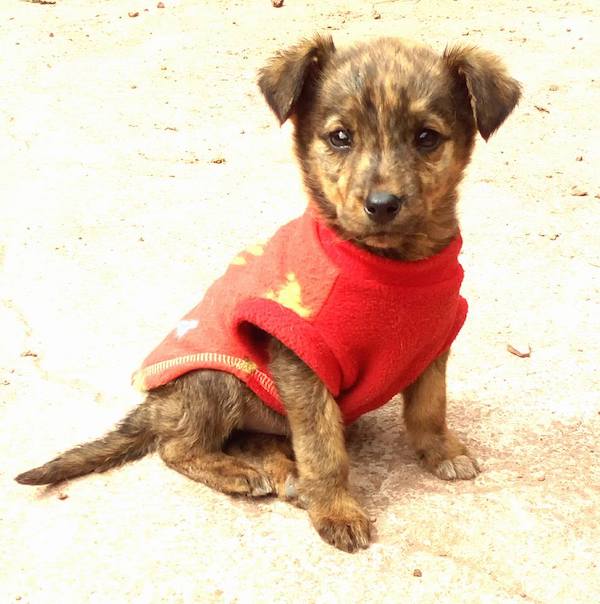
Baby Mimi! Courtesy of Cusco Protección de Animales.
On the way to my next site visit that afternoon, I texted a photo of Mimi to my parents.
“I’m adopting this colorful dog.”
The International Pet Adoption Process: Paperwork and Scheduling
After wrapping up the Peru trip, I settled into my new role as the caretaker for my parents’ vacation home in Pine Island, Florida. I wasn’t sure whether I would stay in Florida or move abroad and live the expat life, but I knew I wanted Mimi with me either way.
The adoption process wasn’t as easy as signing some paperwork and hopping on a plane with Mimi. It actually took about five weeks to bring her home.
Cusco Protección de Animales works with a local veterinarian to ensure that the shelter’s dogs and cats are healthy and have all their vaccinations. They also work with an organization called PetWings, which arranges international travel, as well as State Department paperwork, for adopted pets. To bring a dog into Florida, you need to have full veterinary records and confirmations of a clean bill of health and all vaccinations, plus other customs paperwork.
For the next few weeks, I stayed in touch with the shelter and PetWings.
The first obstacle was the car.
Being a digital nomad for so long, and living in a city with a good metro system for years before that, I didn’t own a car. The local Pine Island Facebook group was a big help for finding people who could lend their cars and time.
The day before Mimi was scheduled to arrive, I connected with someone who had a truck large enough to accommodate Mimi’s crate, and who was able to take an entire day to drive back and forth from Pine Island to Miami. Katie was a student, and was out of school for the summer—we agreed on $200 to cover gas and time, and left in the early afternoon the next day to arrive to Avianca cargo at Miami International Airport well in time for Mimi’s arrival.
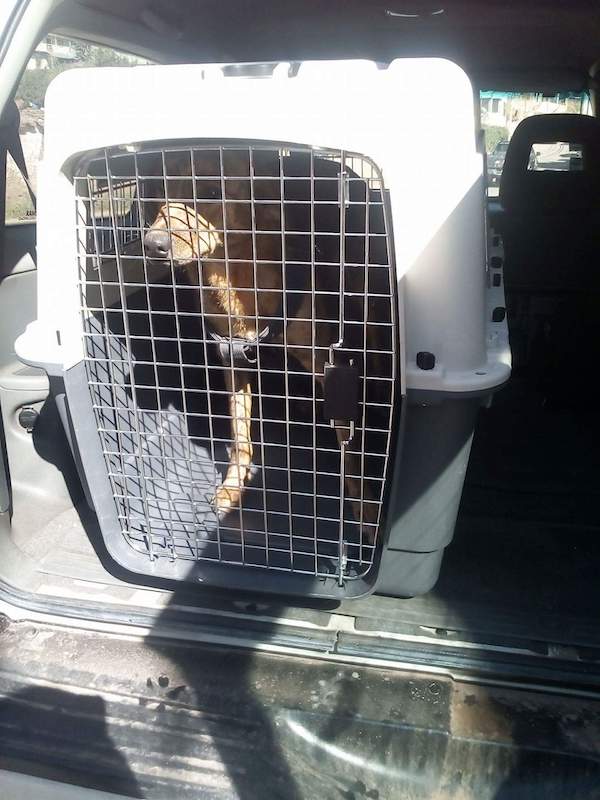
Mimi in her crate, ready to fly to Florida! Photo courtesy of PetWings.
A Perfect Storm
We arrived to Avianca cargo about 20 minutes before Mimi’s flight was scheduled to land. I checked in with the desk agent, who looked over the packet of paperwork I’d been given to present for Mimi, and he told us to have a seat and wait—it would take at least another hour after landing to bring Mimi through customs and immigration. Katie was fine waiting alongside me, which I was incredibly thankful for. We sat and talked, texted friends, and waited for the hour to pass. I became antsy after an hour-and-a-half, and began checking the flight tracker.
A red update flashed across my screen: Mimi’s flight was delayed coming into Miami and hadn’t landed yet.
I asked the desk agent if he knew whether the flight was delayed on take-off, because the tracker hadn’t noted it before. He said that there was a thunderstorm close by, so the plane was circling until it was safe to land.
Another hour passed. I began texting my best friend Dave, who happened to live in Miami, asking if I might be able to bring Mimi to his place and stay overnight as a worst-case scenario. He said we were more than welcome, and Katie, ever-patient, said she had no problem waiting even if it took another hour.
A half-hour later, the agent beckoned me over. “They’ve diverted the flight to Tampa.”
I crumbled.
We’d been waiting almost three hours, and I had no idea if Mimi would still arrive that night or the next morning—and whether she would have enough food and water, and was able to leave the crate to do her business instead of sitting in her own filth.
I started crying, pathetic, with my head in my hands. The agent was extremely sympathetic, and said it might be best to head home for a bit. It would be at least three more hours before the flight came in. He wrote down the front desk number to check on the arrival so I could pick Mimi up later.
I trudged back to my seat, pulled $200 out of my wallet, and handed it to Katie. “My friend lives close by—would you mind driving me there? I’ll figure out the rest later.” Probably among the most awkward, sad moments of my life. For Katie’s part, she was a total sweetheart and said it was no problem.
I texted Dave again, who let me know he wasn’t home yet, but his roommate could let me in.
Let’s Try This Again
For the next three hours, I hung out at Dave’s apartment and got to know his roommate Terrell, who loves dogs, and was excited to meet Mimi. The flight took off from Tampa, and I tracked it until 11:00pm, when it was close to landing in Miami.
I dialed the Avianca cargo desk, and the woman who answered asked, “Oh, are you the girl with the doggie? Come on over; we’ll have her here for you soon.”
As Dave still wasn’t home yet, I called an Uber to the cargo center, and am absolutely certain the driver thought I was going to murder him. It was close to midnight, and I was asking him to go to the cargo warehouse area of the airport—and to the last building in a line of three warehouses. He asked several times, “Are you sure this is where you want to go?” and I tried explaining I had a dog arriving in cargo, but there was a little bit of a language barrier.
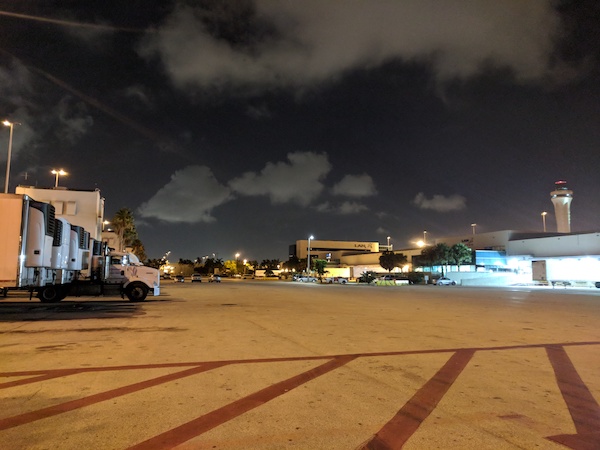
Near midnight at the Avianca cargo warehouse at Miami International Airport
The woman at the front desk looked over Mimi’s paperwork, and stapled another form to it, saying that I needed to have TSA clear her to be released. Right then, Dave pulled up—hooray!
We both headed over to the TSA office, found the (seemingly) only person working that night, and got his signature. Back at Avianca cargo, they stamped our paperwork, handed it back, and said Mimi was two warehouses down.
Back to the car! Dave and I drove down to the warehouse and handed the paperwork to the first person we saw there. A few minutes later, he drove a forklift out, carrying Mimi in her crate. They handed her off to us, and we were on our way.
To say she was terrified was an understatement. Mimi was shivering and cowering, having never experienced anything like she’d been through over the past two days, and the warehouse was LOUD. I don’t know how loud it is to be an animal in cargo during a flight, but I imagine it’s not pleasant. We gave her lots of pets and cuddles as we loaded her into Dave’s car, and headed back to his apartment.
Settling in to a New Home
Although Mimi was scared and in a new place, she gobbled up her food and cuddled up with us. Dave set up an old comforter and pillows on the floor next to his bed that night for Mimi to sleep on, but she ignored it and jumped up right next to him.
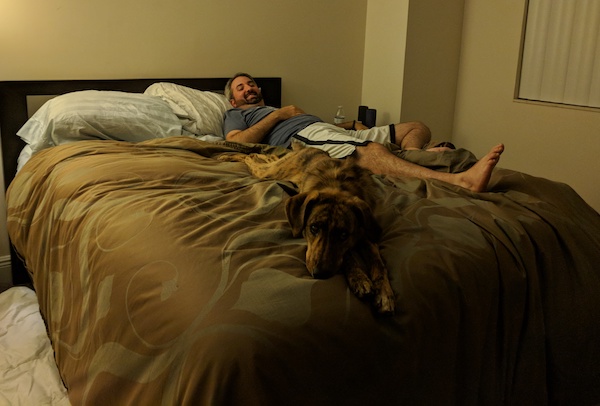
You can see some of the comforter that Mimi ignored in the lower left.
Over the next few days, she opened up, played with her toys, and decided that being around me and Dave wasn’t so bad.

In addition to the bed, Mimi claimed this couch as her own.
That weekend, Dave drove us back over to Pine Island, which became Mimi’s home for the next year. She had a nice yard to run around in, lots of lizards to chase—and because this house had two guest rooms, three different beds she could choose from! (Though she usually stayed in whichever bed I decided to sleep in).
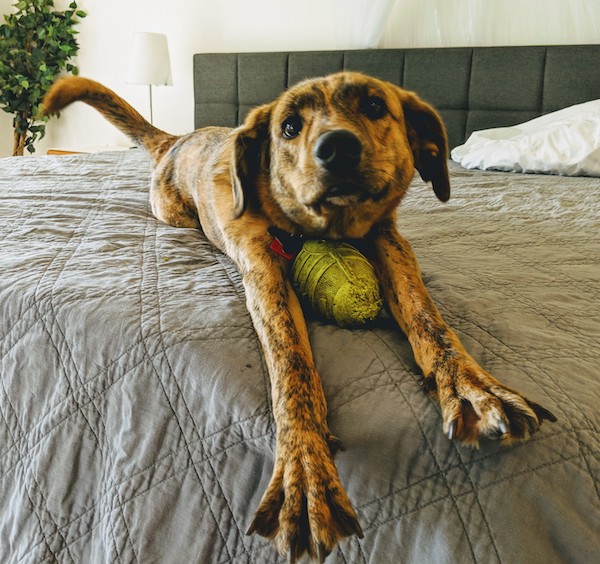
Mimi’s favorite bed
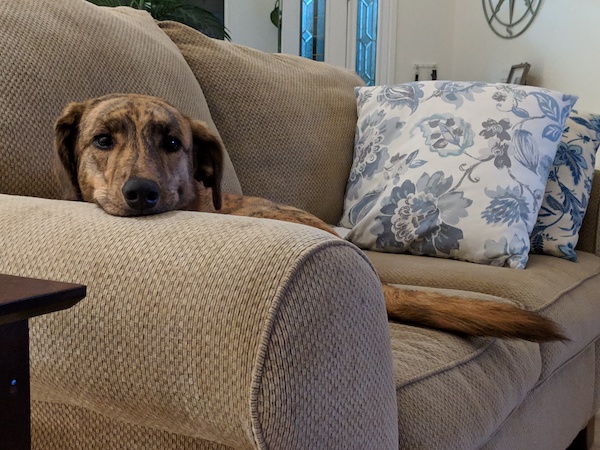
The loveseat belongs to her too

Enjoying the sun by the pool
We’ve since moved to Miami to be closer to Dave—obviously he and I began dating shortly after he helped me bring Mimi home (and we got married a couple years later, with Terrell serving as my man of honor!). And after trying the apartment thing for a bit, Dave and Mimi and I now live in our own little house with a nice yard and lots of room for her to zoom around, bury bones, and once again chase all the lizards she could ever want.
She is a sneaky, playful, wonderful dog, and I’m so glad she’s part of this fun little family! The adoption process was definitely a little more complicated than one might imagine, but in all, it was just a couple days of confused rushing around, all for years of companionship and love with this wonderful tiger-striped dog.
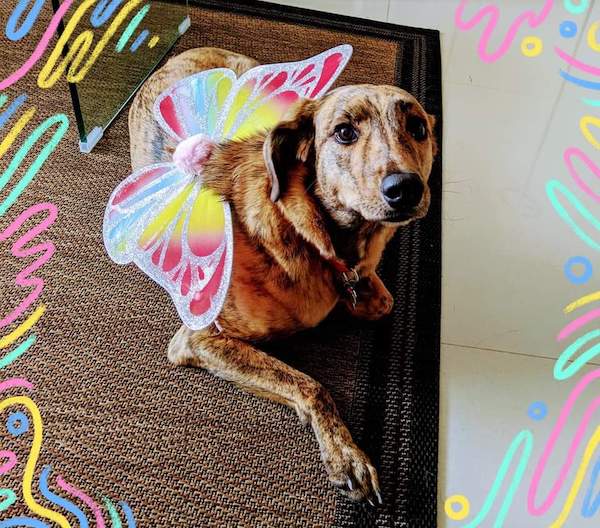
Mimi on her birthday! She hated these butterfly wings, though.
About the Author
 As the editor-in-chief of Frayed Passport, my goal is to help you build a lifestyle that lets you travel the world whenever you want and however long you want, and not worry about where your next paycheck will come from. I've been to 20+ countries and five continents, lived for years as a full-time digital nomad, and have worked completely remotely since 2015. If you would like to share your story with our community, or partner with Frayed Passport, get in touch with me using the form on our About page.
As the editor-in-chief of Frayed Passport, my goal is to help you build a lifestyle that lets you travel the world whenever you want and however long you want, and not worry about where your next paycheck will come from. I've been to 20+ countries and five continents, lived for years as a full-time digital nomad, and have worked completely remotely since 2015. If you would like to share your story with our community, or partner with Frayed Passport, get in touch with me using the form on our About page.All images courtesy of the author.
Information published on this website and across our networks can change over time. Stories and recommendations reflect the subjective opinions of our writers. You should consult multiple sources to ensure you have the most current, safe, and correct details for your own research and plans.
Frayed Passport is a participant in the Amazon Associates Program, an affiliate advertising program designed to provide a means for sites to earn advertising fees by advertising and linking to Amazon.com. We also may share links to other affiliates and sponsors in articles across our website.




